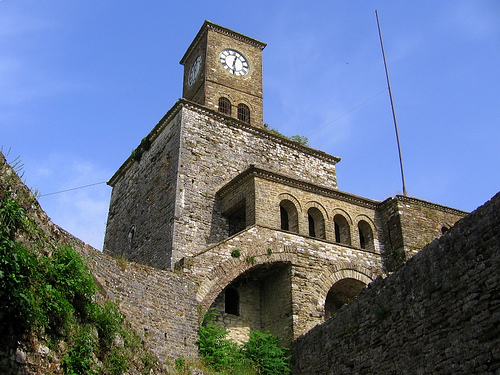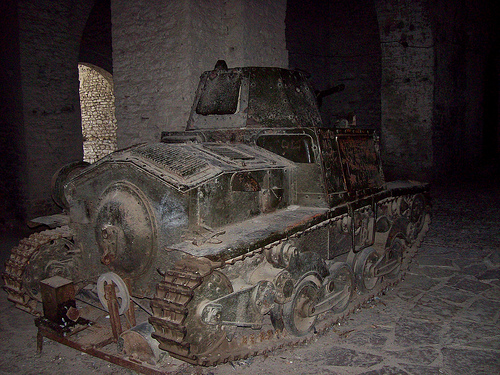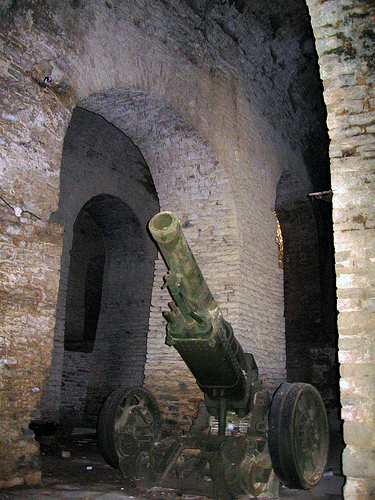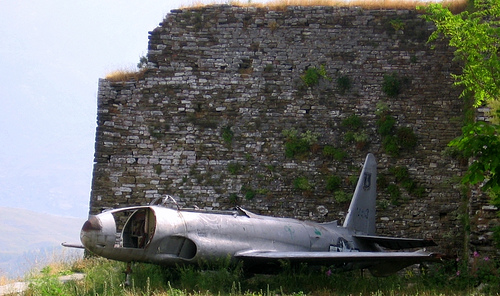

Hotels, motels and where to sleep
Restaurant, taverns and where to eat
Cultural (and not so cultural) events
Gjirokastër is a city in the south of Albania, in the valley of the Drina River. It is the administrative center of the region and district of the same name. Population 22.8 thousand people (2004). Gjirokastër has the status of a city-museum and is known as the birthplace of the Albanian communist leader Enver Hoxha. In 2005, the city was included in the UNESCO World Heritage List as a well-preserved city from the Ottoman Empire.


Built: 12th century
Gjirokastër Castle was originally constructed in the 12th century to guard
the strategic route in the river valley below. Western additions were
ordered by Ali Pasha of Tepeline in 1812. At the time of the Ottoman
Empire, this historic fortress was called Ergiri, and the local
Greeks called it Argirokastro, the name also applied to the castle.
Castle Gjirokastra located at an altitude of 336 meters.
Gjirokastër castle was built in the 12th century to protect the
river valley below. During Ottoman rule, the castle remained an
important strategic fortress for the protection of the empire from
the West. The western walls were added by Ali Pasha Tepelin in 1812
after his successful military campaign. The Albanian king Zog
increased the castle and turned it into a prison in 1932.
Today the castle is open to visitors. Here you can see a collection
of military equipment during the Second World War and the Cold War.
Part of the weapon was captured by Albanian partisans during
military operations against the Wehrmacht. Most American planes got
here after they "accidentally" flew into the territory of Albania.
The castle is located in
the upper part of a one kilometer long, narrow ridge on the eastern
slope of Mali i Gjerë, which rises around 200 meters above the flat
floor of the Drino valley and extends down into the plain. The range
of hills drops steeply to the south and north, but due to the lack
of rocky terrain, high defensive walls had to be built. The
fortified structure is 500 meters long and up to a maximum of 90
meters wide. At the narrowest point, the width barely exceeds ten
meters.
The system can be roughly divided into four sections.
The western quarter is quite narrow with vaults built after 1811 and
a narrow garden with a Bektashi doorway that contains the tombs of
two babas from the 16th and 17th centuries. The next third contains
the central buildings with the main entrance and the former prison.
The next third contains wide open areas that are used today as a
festival stage - and auditorium - and under which there are large
cisterns. In the far east of the castle there is a bastion and
another entrance, above which the city clock tower from the 19th
century.
The castle has seven towers. It used to be possible
to walk through vaults along the entire length of the castle. A
third gate was on the south side, opposite the main entrance.
Rr. Hysen Hoxha, 3
The Ethnographic Museum is located in the Palorto
area, considered one of the best-preserved and most prestigious
quarters of the old town of Gjirokastër. The Museum of Ethnography
stands on the site of the former residence of Enver Hoxha, the
permanent dictator of communist Albania (reigned from 1944-1985).
The new premises of the current museum were built in 1966, after the
original building was badly damaged by fire. The model for the
renovation was a traditional house of Gjirokastër architecture with
classical features that are found throughout the city.
From
1966 to 1991, the building served as a place for the exposition of
the anti-fascist museum. In 1991, the exhibits from the previous
building were moved to these areas. The house has four floors, and
all of them are open to the public. The rooms themselves - the halls
of the museum are also exhibits: they are located as they were
actually used in everyday life. They display numerous household
items, folk costumes and cultural artifacts of a typical wealthy
family of merchants or Ottoman administrators who lived in
Gjirokastra in the 19th century.
The Gjirokastër Mosque, known as the Bazaar or New
Mosque, was built in 1757. The mosque is located next to the Old
Bazaar. It is one of the fifteen first built Islamic places of
worship during the Ottoman rule, and one of the thirteen that
survived until the period of communism.
The mosque was
originally located next to the New Bazaar of Gjirokastër and was
part of the 17th century Memi Pasha urban development plan. But all
buildings were destroyed by fire in the next century, with the
exception of the mosque. It was granted the status of a cultural
monument by the Albanian government in 1973, which saved it from
complete destruction during the totalitarian communist regime in
Albania. The remaining twelve mosques were subsequently destroyed.
Due to the prohibition of religion in Albania, the mosque was used
as a training hall for circus acrobats, for whom the high vaults of
the inner space were suitable for hanging trapezoids there.
Externally, the mosque is a two-story octagonal building of
traditional Ottoman architecture. Inside, under the vaults, the
ceiling mosaic has been partially preserved. Currently, the mosque
is used as a madrasah.
Old Bazaar and Historic Ottoman
Homes. The old bazaar is still the social and commercial center of
the Old Town of Gjirokaster. Though the newer sections of the city
have attracted many businesses and people, the bazaar and its
surrounding homes dating from the 18th, 19th and early 20th
centuries still manages to capture a bit of the bygone era of
Gjirokastrite life. Several of the houses are at various levels of
restoration and are open to the public. Traditional houses include
Cabej House, and Topulli House. The Bazaar has undergone a cleaning
and exterior restoration as part of the government's revitalization
plan.
Kadare House. House of renown writer Ismail Kadare
undergoing reconstruction.
Skenduli House. A renovated
traditional house.
Zekate House, Rruga Mazllëm Shazivari, (in the
historic Palorto quarter). It is the most visited of Gjirokastër's
monumental stone houses. It is one of the largest of its kind,
featuring three floors spread over two large towers. The house was
recently restored again (having undergone earlier restorations
during the Communist era) and is kept open by its owners as a museum
house. In addition to providing an interesting primer of the
characteristic architectural elements of the city's tower houses, it
offers a beautiful view of the city below.
Saint Sotira Church
(in the Old Bazaar quarter). every day between 07:00-07:30 and
19:00-19:30; Sunday Service takes place between 07:00 and 10:00 can
also be visited upon request. this is a well preserved 18th century
Orthodox Church.
Gjirokaster Mosque, Rruga Gjin Zenebisi (in the
Old Bazaar). This mosque is a true testimony of the communist
religious ban in Albania. Spared from destruction from its religious
importance, the mosque was transformed as a circus training centre
only to return to its original setting after the 1990s in the form
of a Muslim school.
Seven Fountains, Mechite Mosque Remains, and
the Hamams. The fountains and the exterior of the Hamams have been
restored. One can observe the dedicatory inscriptions on the
fountains and the cone shaped traditional roofs of the Hamams.
Cold War Museum. Underground bunker of Enver Hoxha with around 70
rooms built for emergency situations.
Sofratike (Sofratikë) (14 km South east of
Gjirokastër). Site of an ancient theater and baths
Kardhiq (20
km North west of Gjirokastër). site of an ancient castle
Paleokaster (Palokastër) (12 km north Gjirokastër). Site of an
ancient village.
Labove (Labovë e Sipërme, Labovë e Madhe) (20
km east via Libohove). Home of one of the oldest standing Orthodox
churches in the Balkans and Tombs of Ali Pasha's sister and nephew
in Libohove village.
Tepelena (33 km North west of Gjirokastër).
the fortress of Ali Pasha
The Illyrian city of Antigone (Qyteti
i vjetër i Antigonesë), near the village of Asim Zeneli (roughly 6
km east). This village is the starting point of a 3-hour round trip
hike to the ruins of Antigone; it makes a nice day hike for the
physically fit (you will want to hire a local shepherd as a guide)

The hill was already inhabited in the Stone Age (8th - 7th
centuries BC) and in the 5th century BC or first attached in
Hellenism. In the 12/13 century there was a fortification with
several towers. At that time the region was under the rule of the
Zenebishi. After Albania was conquered by the Ottomans, the fortress
was renewed and expanded under Bayezid II, who also had the first
mosque built. The castle continued to grow over the centuries.
The originally inhabited fortress, which was the starting point
for the development and named after the city, expanded into the
suburb (Varosh) on the eastern edge of the hill in the 15th century.
Today's castle is characterized by the new building with
extensions to the west and east, which Ali Pascha had Janina
implement in 1811/12 in a year and a half. A ten-kilometer-long
aqueduct was built under him, which ultimately led via an aqueduct
(completely demolished in the 1930s) water into the cisterns of the
castle. A bridge over the water pipeline still stands above the
city.
The prison at Gjirokastër Castle was established in
1932 under King Zogu, was used by the Italian and German occupiers
during World War II, and housed political prisoners during the
communist regime until it was closed in 1968.
Since 1968 the
National Folklore Festival has been held at the castle every four to
five years. Since 1971 the castle in the casemates has housed the
"National Arms Museum" and since 2012 the "Gjirokastra Museum" on
the history of the city and region. The military museum shows old
cannons, armored cars and captured artillery as well as memorabilia
from the communist resistance against the German occupation in World
War II. A special attraction are the remains of a Lockheed T-33 of
the United States Air Force that had to make an emergency landing in
Kuçova in 1957.
Like the entire old town of
Gjirokastër, the castle is a UNESCO World Heritage Site.
It
is open to visitors and has been a major tourist destination in
recent years. It was visited by over 10,000 Albanian and foreign
tourists from January to May 2018. This was more than double the
number of visitors from the same period last year with 4,700
visitors.
By plane
Tirana Airport (Tirana
International Airport Nënë Tereza, TIA) is located 222 km north of
Gjirokastra. Alternatively, you can also fly to Corfu / Greece
(Ioannis Kapodistrias International Airport, CFU), from there take
the ferry to the sea port of Saranda and cover the remaining 56 km
by bus or taxi to Gjirokastra.
By train
Gjirokastra has no
connection to the (barely existing) route network of the Albanian
railway (Hekurudha Shqiptare, HSH).
In the street
Gjirokastra is located on Albania's most important north-south
connection, the SH4 (E853), which connects Tirana with Greece
(Kakavia border crossing). The road is very well developed by
Albanian standards.
Gjirokastër can be divided into roughly two halves, the old town up on the hill, and the new town in the valley below. You can walk just about anywhere if you're able to handle the steep cobbled streets. Taxis in Gjirokastra are cheap and there is a public bus circuit that connects the old town and the new town for about 30 leke. From the roundabout at the center of town to the bus station on the National Road is a fairly flat, easy, 10-minute walk along the main boulevard. Taxis will make this trip for around 200 leke.
Kotoni Bed&Breakfast, Rr. Bashkim Kokona, 8, ☎ +355 84 263526,
e-mail: info@kotonihouse.com. The first guest house in Gjirokastra,
since 1992, comes up with more traditional rooms and a
characteristic restaurant. Each room has coloured satellite TV,
bathroom, heating. 200 m from the old bazaar, you can have a great
view of the old and new part of the town. - +phone=+355 69 23 66 846
€30.
Hashorva Guesthouse, Rr. Varosh, e-mail:
HashorvaGuestHouse@gmail.com. The Hashorva Family, a well
established name in the Lagjia Varosh Neighborhood, offers one very
large, faithfully restored traditional Ottoman Era room, with a
double bed and sitting area. The house is over 200 years old and is
kept in wonderful condition by its original owners. Naturally cool
in the summer, the guest bathroom is off the main hallway with
24-hour hot water and modern facilities. It's in the heart of
Gjirokastër, an easy 5 to 15 minutes walk from all the major sites
of Historic Old Town and 10 minutes walk to the new town and the bus
station on the National Road. The large guest room is €20/night - it
has a large double bed, a single bed off to the side. (Payment can
be made by cash only in Albanian lek, euros or US dollars - Or you
can book in advance online using a credit card at
http://www.hostelworld.com/)
Hotel Relax, streets Sheshi i Çerçizit. 9 double rooms and 1 suite,
with A/C. This wonderful hotel lies at the foot of the hilly center
of beautiful Gjirokaster. It is a small hotel owned by a very sweet
family. The father handles business, and is helped by his nice
teenage daughter. They are incredible friendly and the hotel is very
clean and has everything you need, including a cosy sitting area and
balcony, overlooking the square. There is a bar downstairs, also
owned by the family, so after visiting Gjirokaster it is perfect to
relax and have a drink. €25 inc. breakfast.
Hotel Sopoti (Sopoti
Hostel), Pazar i Vjeter (Old Pazar, Gjirokastër). Check-in: anytime,
check-out: 11:00. A formerly grand hotel, it feels somewhat
forgotten; rooms are basic, ask for one with a balcony to get a view
of the castle, bathrooms are shared. The manager of the hotel is a
refined older gentleman who also runs the bar/kafe downstairs. He
knows some English. 1000 leke/person. editprice is 1200 lek per
person. If you ask for wifi internet (which doesnt seem to happen
very often) you will be given the password for a nearby cafe, but it
is too far away so it can only work betwwen 03:00 and 06:00 when
nobody else uses it. still a good choice for a single traveller as
it is cheaper than a dorm bed in one of the towns hostels
Hotel
Gjirokaster. Modeled after a traditional Ottoman House. Excellent
location that is half-way between the castle and the market area.
Friendly staff and free breakfast included.
Gjirokastër is known for its Qifqi (baked dish made of rice, egg,
and seasonings). The city is also well known for its dairy products,
especially its white cheese.
There are also well established
restaurants in Gjirokastër catering to travellers and the local
crowd.
Old town
Fantazia – specializes in pizza and salad,
but offers traditional Albanian fare, good views of the city.
Kujtim's – serves a wide variety of Gjirokastrian specialties.
The newly renovated Çajupi Hotel's Terrace Restaurant,
The Byrek
Shop
Muço's Suflaç & Restaurant – Good omelets in the morning
Hajri's Coffee Bar
Sopoti Cafe
New town
Kufoi's, Pizza
Erai
Antigone Fast Food Suflaç,
Suflaç at the Hotel One
Restaurant
Modus Cafe – for coffee
Viroit Park (Parku i Viroit), Parku i Viroit (located 2 km north,
along the SH4). A park encompassing the Viroi Lake and surrounding
hills. The park features a relaxing environment and an accommodation
area.
Events
National Folklore Festival. A festival
showcasing traditional Albanian music and dance considered as the
most important event in its genre. Held every 5 years since 1968 in
Gjirokaster Castle, it was last held in May 2015. An artisans'
exhibition took place as well.
Buy
Take a look at the
Artisans' Center near the Information Center featuring many
souvenirs and traditional crafts.
Internet
There are internet cafes in
Gjirokastër which usually charge between 50 and 100 lek per hour.
Internet Kafe (Opposite the mosque)
Google Internet Kafe
There are also a few cafes which provide free wireless:
Hotel
Cajupi (on the roof top terrace/cafe)
Restaurant Kuka
Bar
Karamel
Bar Grand
Gulf fuel station on the road to Saranda. A
coffee is 100 lek, doubtful if you may find a cheaper option
Consulates
Greece Greece, Konsulata e Pergjithshme e
Greqise - Sheshi I Cercizit, Gjirokaster, ☎ +355 8426 3804, +355
8426 2010 (Emergencies), fax: +355 8426 8141, e-mail:
grgencon.arg@mfa.gr. M-F 09:30-16:30.